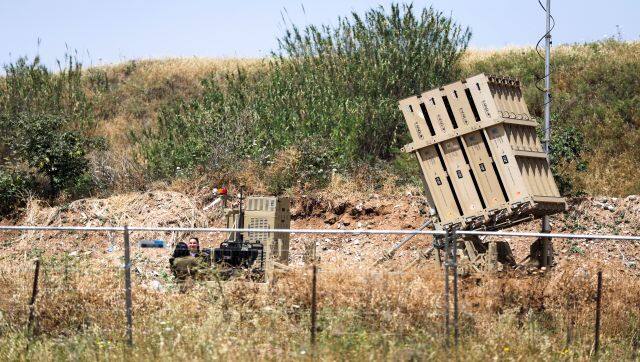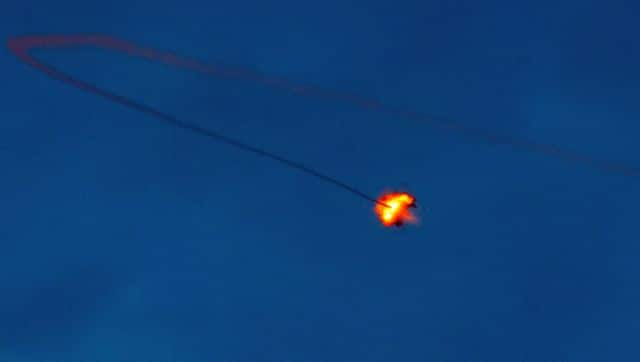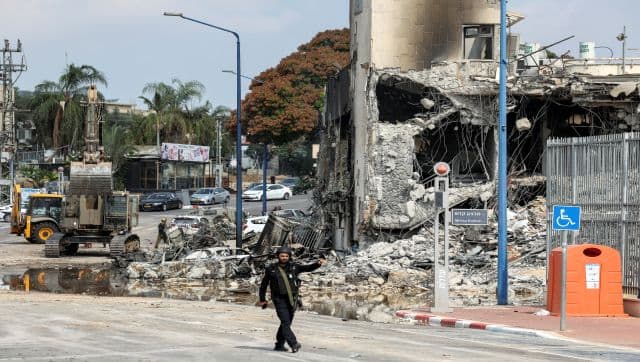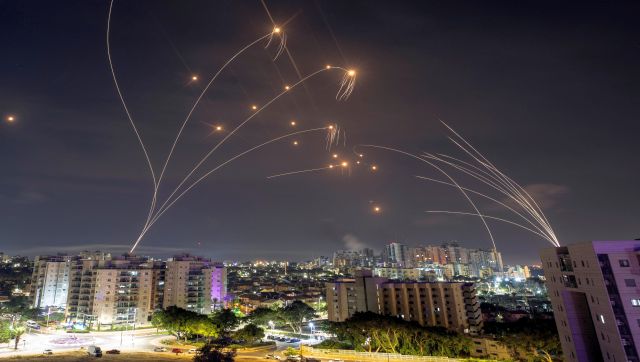Israel is at war. It’s Day 2 of gun battle after the Palestinian terror group Hamas launched one of its biggest and deadliest attacks against Israel on Saturday (7 October), prompting Israeli’s Benjamin Netanyahu to announce that his country was now “at war”. “What happened today has never been seen in Israel. We will take mighty vengeance for this black day,” Netanyahu said in a televised speech on Saturday. “Israel will reach every place Hamas is hiding.” The surprise attacks have since claimed the lives of at least 350 people and caused unprecedented damage and destruction. Mohammed Deif, head of the Palestinian group’s military wing al-Qassam Brigades announced the group had fired over 5,000 rockets in the “first strike of 20 minutes” under ‘Operation Al-Aqsa Flood’ on Saturday. In addition, the group also launched ground attacks, infiltrating military bases and overrunning parts of two southern Israel towns, taking hostages in the process. Amid the gun battle, many questions are being raised? Is it an intelligence failure on the part of Tel Aviv? How was Hamas able to launch a barrage of rockets against Israel’s famous Iron Dome – an air defence system meant especially for this purpose? We take a closer look at what exactly is the Iron Dome air defence system? How does it work and how equipped is it during an all-out war? What is the Iron Dome? The Iron Dome, operational since 2011, is Israel’s short-range air defence system known for taking down largely unguided rockets fired from Palestinian territory. It was first created by Israeli firms Rafael Advanced Defense Systems and Israel Aerospace Industries with some support from the United States. The genesis of the Iron Dome came after the 2006 Lebanon conflict when thousands of rockets were launched into Israel, causing huge damage, mass evacuations and dozens of deaths. After that Israel said a new missile defence shield would be developed. The Iron Dome is used for countering rockets, artillery & mortars (C-RAM) as well as aircraft, helicopters and unmanned aerial vehicles. As NDTV reports, it has a range of approximately 70 km and has three central components that form a unit, namely; Detection and Tracking radar, Battle Management and Weapons Control and the Missile Launcher armed with 20 Tamir Missiles.
It is effective in all weather conditions, including during the day and night. The Iron Dome doesn’t take down each and every rocket fired; it relies on radar and artificial intelligence (AI) to determine whether an incoming trajectile is a threat and only fires when the incoming rocket is running the risk of hitting a populated area or infrastructure. If the system determines there is no danger, then it allows the rocket to land. The manufacturer of the Iron Dome states that the success rate of the air defence system is as high as 90 per cent, but experts agree the success rate is over 80 per cent. [caption id=“attachment_13219022” align=“alignnone” width=“640”] A view of an Iron Dome launcher, which is used to fire interceptor missiles against Hamas. File image/Reuters[/caption] However, the Iron Dome doesn’t come cheap. In fact, a lot has been said about its cost. Each battery, or the full unit, can cost over $50 million (Rs 415 crore), and one interceptor Tamir missile costs around $80,000 (Rs 66.5 lakh). But Retired Air Marshal Anil Chopra, who heads the Centre for Air Power Studies (CAPS) think tank in New Delhi, told the Indian Express that it is not the right way to judge its cost effectiveness. “If I have to take… rockets, which cost very little, and I am firing any missile, then it’s an expensive exercise.” “But it proves a deterrent,” he told the newspaper, “Additionally, the morale of the nation is maintained as it doesn’t get intimidated by rockets.” This has been echoed by Jean-Loup Samaan, a research affiliate with the Middle East Institute at the National University of Singapore who has studied Israel’s missile defence. Speaking to Vox earlier, he said that the Iron Dome is an “insurance policy”; it reassures citizens and protects against loss of life and property damage. [caption id=“attachment_13219062” align=“alignnone” width=“640”]
A view of an Iron Dome launcher, which is used to fire interceptor missiles against Hamas. File image/Reuters[/caption] However, the Iron Dome doesn’t come cheap. In fact, a lot has been said about its cost. Each battery, or the full unit, can cost over $50 million (Rs 415 crore), and one interceptor Tamir missile costs around $80,000 (Rs 66.5 lakh). But Retired Air Marshal Anil Chopra, who heads the Centre for Air Power Studies (CAPS) think tank in New Delhi, told the Indian Express that it is not the right way to judge its cost effectiveness. “If I have to take… rockets, which cost very little, and I am firing any missile, then it’s an expensive exercise.” “But it proves a deterrent,” he told the newspaper, “Additionally, the morale of the nation is maintained as it doesn’t get intimidated by rockets.” This has been echoed by Jean-Loup Samaan, a research affiliate with the Middle East Institute at the National University of Singapore who has studied Israel’s missile defence. Speaking to Vox earlier, he said that the Iron Dome is an “insurance policy”; it reassures citizens and protects against loss of life and property damage. [caption id=“attachment_13219062” align=“alignnone” width=“640”] An Israeli missile launched from the Iron Dome defence missile system attempts to intercept a rocket, fired from the Gaza Strip, over the city of Netivot in southern Israel. AFP[/caption] It’s important to note here that the Iron Dome isn’t effective against more potent missiles, for instance, a ballistic missile. Those missiles are bigger and faster, with longer and steeper trajectories. Iron Dome is specifically for shorter-range threats. The success of the Iron Dome has generated a lot of interest from other countries – parts of it have already been sold to countries like Canada, Britain, the Czech Republic and Slovakia. However, Israel has refrained from selling the system to Ukraine, despite Kyiv repeatedly requesting to purchase the costly technology to protect its civilians from heavy Russian shelling during the ongoing war. [caption id=“attachment_13219032” align=“alignnone” width=“640”]
An Israeli missile launched from the Iron Dome defence missile system attempts to intercept a rocket, fired from the Gaza Strip, over the city of Netivot in southern Israel. AFP[/caption] It’s important to note here that the Iron Dome isn’t effective against more potent missiles, for instance, a ballistic missile. Those missiles are bigger and faster, with longer and steeper trajectories. Iron Dome is specifically for shorter-range threats. The success of the Iron Dome has generated a lot of interest from other countries – parts of it have already been sold to countries like Canada, Britain, the Czech Republic and Slovakia. However, Israel has refrained from selling the system to Ukraine, despite Kyiv repeatedly requesting to purchase the costly technology to protect its civilians from heavy Russian shelling during the ongoing war. [caption id=“attachment_13219032” align=“alignnone” width=“640”] A member of Israel’s security walks past a police station which was the site of a battle following a mass infiltration by Hamas gunmen from the Gaza Strip, in Sderot, southern Israel. Reuters[/caption] So, what happened on Saturday? On Saturday (7 October), Hamas, the Palestinian terror group, who has long been trying to find a weakness in the Iron Dome over powered the defence system. They
overwhelmed the system
– firing over 5,000 rockets in less than 20 minutes, making it difficult for the control system to intercept all targets. News18 has reported that Hamas is also developing its crude rocket technology and it has increased its range to cover major cities of Israel including Tel Aviv and Jerusalem. Moreover, a rocket launched by Hamas is much cheaper than the Tamir missile fired to intercept it. In fact, following the attacks, Iran’s Nournews reported that Israel could not predict their operations, and that its Iron Dome was nothing but a dome of straw above a sand castle. Moreover, Hamas didn’t restrict itself to just rocket launches. Hamas terrorists travelled in vehicles, boats and motorised paragliders. They breached Gaza’s security barrier and attacked nearby Israeli towns and military posts, opening fire on residents and passersby. With inputs from agencies
A member of Israel’s security walks past a police station which was the site of a battle following a mass infiltration by Hamas gunmen from the Gaza Strip, in Sderot, southern Israel. Reuters[/caption] So, what happened on Saturday? On Saturday (7 October), Hamas, the Palestinian terror group, who has long been trying to find a weakness in the Iron Dome over powered the defence system. They
overwhelmed the system
– firing over 5,000 rockets in less than 20 minutes, making it difficult for the control system to intercept all targets. News18 has reported that Hamas is also developing its crude rocket technology and it has increased its range to cover major cities of Israel including Tel Aviv and Jerusalem. Moreover, a rocket launched by Hamas is much cheaper than the Tamir missile fired to intercept it. In fact, following the attacks, Iran’s Nournews reported that Israel could not predict their operations, and that its Iron Dome was nothing but a dome of straw above a sand castle. Moreover, Hamas didn’t restrict itself to just rocket launches. Hamas terrorists travelled in vehicles, boats and motorised paragliders. They breached Gaza’s security barrier and attacked nearby Israeli towns and military posts, opening fire on residents and passersby. With inputs from agencies
)